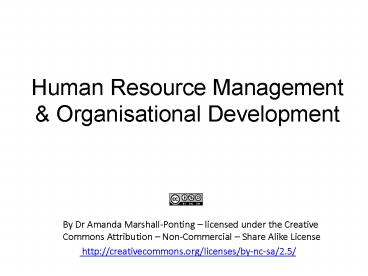Human Resource Management - PowerPoint PPT Presentation
1 / 23
Title:
Human Resource Management
Description:
Human Resource Management & Organisational Development By Dr Amanda Marshall-Ponting licensed under the Creative Commons Attribution Non-Commercial ... – PowerPoint PPT presentation
Number of Views:43
Avg rating:3.0/5.0
Title: Human Resource Management
1
Human Resource Management Organisational
Development
By Dr Amanda Marshall-Ponting licensed
under the Creative Commons Attribution
Non-Commercial Share Alike License
http//creativecommons.org/licenses/by-nc-sa/2.5/
2
Structure of the work package
3
Structure of the work package
Tests, reflective questions problem scenarios
Theoretical models key debates
Additional reading
4
Management, what is it?
- To manage is to forecast and plan, to organise,
to command, to coordinate and to control - (Fayol, 1916)
- And
- Organizations are set up to achieve purposes
that individuals cannot achieve on their own.
Organizations then provide a means of working
with others to achieve goals...likely to be
determined by whoever is in the best position to
influence them... A key characteristic of
organizations is their complexity. - (Stewart, 1994)
5
Main management schools of thought
6
Classical management theories
- This section presents the classical management
theories associated with - Henri Fayol
- Fredrick Taylor
- Max Weber
7
Classical management theories Fayols
principles of management
Structural principle Social principle
Division of work Discipline
Authority responsibility Subordination of individual interests to general interest
Unity of command Remuneration
Unity of direction Equity
Centralisation Stability of personnel tenure
Scalar chain Initiative
Order Esprit de corps
8
Classical management theories Taylors
scientific management
1913
1914
12.5 hours
1.5 hours on assembly line
9
Classical management theories Webers
bureaucratic management
- The importance of authority in enabling the
organisation to become operationally more
efficient. - 3 basic types of authority
- Traditional authority accepted based on
tradition - Charismatic loyalty based on personal qualities
of the ruler - Rational-legal based upon a persons position
and bounded by rules procedures
10
Social management theories Elton Mayo
- Two identical assembly lines
- Work conditions were changed for one assembly
line - Production increased no
- matter how the conditions
- changed
11
Social management theories Herzbergs two
factor theory
12
Social management theories Maslow hierarchy of
needs
13
Social management theories Druckers management
by objectives
14
Recruitment, selection, retention
15
Staff motivation and turnover
- EXERCISE 1 You can motivation and its impact
upon staff turnover by completing exercise 1. - This exercise asks you to think about why staff
turnover rates vary between industries or sectors
and the factors that may account for these
differences.
16
Reward management
- One means of maintaining staff motivation
- Incentives include salaries, bonuses,
commission, profit sharing - An employees intrinsic needs should also be met
by incentives such as - Job variety
- Recognition
- Responsibility and decision-making opportunities
- Career and skills development
17
Reward management
- McKenna Beech (2002) identified five main types
of reward schemes - Time rates
- Payment by results
- Individual/group performance pay
- Profit related pay
- Cafeteria or flexible benefits
18
Motivation and incentive schemes in your company
- Exercise 3 asks you to think about the company
you are working for and identify the different
incentives that are used to motivate different
parts of the work force.
19
Appraisal
- Provides opportunity to
- monitor reward performance
- Identify personal career aspiration s training
needs - Aims to correct performance or behaviour
deficiencies whilst rewarding and maintaining
good practice
20
The appraisal process
21
Appraisal good practice
- The appraiser needs
- To be informed about the appraisee attendance,
outputs, commitment - To be sensitive focus on the issues rather than
personal issues - To emphasise the opportunity to mutually agree
objectives plans to achieve them - To summarise main actions points
- To try and provide feedback outside of formal
appraisals
22
Conclusions
- This presentation has provided an overview of the
HRM and organisational performance learning
package. - To deepen your understanding, you should work
through - Background document
- Exercises and reflective questions
- Additional reading
23
Reading































